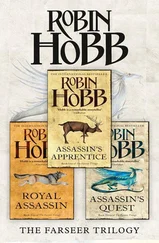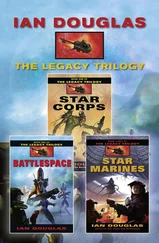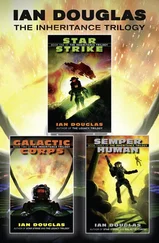He just hoped she had what it took to pull off her mission. Right now, it looked as though the very existence of the United States of America was hanging by a thread.
TUESDAY, 12 JUNE: 1412 HOURS GMT
Star Eagle transport Michael
E. Thornton
LEO
0712 hours PDT
The Star Eagle Michael E. Thornton, a single-stage-to-orbit SCRAMjet transport, had cleared the lower reaches of Earth’s atmosphere and was accelerating now on her rockets, thundering through the fast-thinning traces of air toward the sunrise. Lieutenant Carmen Fuentes, encased in Class-One/Special armor and riding in what by now was effectively vacuum, couldn’t hear the rockets so much as feel them. The passenger module was a quick design that Marines jokingly referred to as “economy class,” with thin padding over hard steel skeletons of chairs.
It was not the most comfortable way to ride to orbit.
The last whispering rumble of the rocket engines died away, leaving Lieutenant Carmen Fuentes and the twenty-two men and women with her in the Star Eagle’s passenger compartment in the free-falling light-headedness of microgravity. The green light at the head of the compartment winked on, indicating that it was safe to move about. Fuentes unsnapped her harness, grabbed a handhold on the overhead, and pulled herself around to face her people.
“Listen up, everyone,” she said over the platoon channel. “I want all of you to stay strapped in. There’s nothing to see in this tin can, so you might as well stay buckled. You’ve all got your TD-patches, so you shouldn’t be spacesick. Any of you do feel sick, use your barf bags. Just remember, it’ll be a long time yet before we can unsuit.”
The passenger compartment for this flight of the Thornton was deliberately unpressurized, which meant the Marines had to stay sealed in their armor all the way up.
“I got the word a few minutes ago,” she continued, using the general talk frequency. “The McCutcheon’s lifted off from Florida and is on her way. We’ll have our backup at the target.”
She could almost sense the relief among the armored forms facing her. The Keith B. McCutcheon was another Star Eagle, identical to the Thornton, but she was coming to orbit with only a few Marines and technicians on board, riding in a pressurized passenger compartment. There would be doctors on board, and a small, microgravity surgery; most important, it would provide the Marine assault team with a place to go, shuck their suits, and stand down for a while. The op at the ISS was expected to take a long time, longer than their suits could carry them.
Fuentes resumed her seat. There were no windows, no display screens, and nothing to see but the cargo bay interior. From time to time, Thornton’s captain called back from the Star Eagle’s cockpit, updating her on their status.
“Lieutenant?” the ship’s captain said eventually. He was a Navy commander named Bryan Mason. “We’re coming up on the target. I’m cracking your overhead now. Make sure everybody’s tied down back there, and watch the light.”
“That’s a roger. We’re all secure here.”
“Copy. Opening up.”
Like the old shuttles, the Star Eagle possessed long, twin doors above the cargo area, and those were slowly opening now, the movement completely silent in the vacuum, though Fuentes could feel the vibration through the hull when she touched it with her glove. She looked up and watched the dark gray hatch panels sliding apart, revealing the inexpressibly lovely, deep blue of the Earth hanging above their heads. She glanced back down at her platoon, watching for the signs she’d been warned about…thrashing about, shaking, any of the possible physical reactions indicating that someone might be going into panic.
There were none. The platoon had been well briefed and well trained.
As the doors swung aside now, sunlight blasted into the interior, darkening the polarized visors of every Marine in the bay. Earth was impossibly blue, impossibly brilliant, a swirl of azure ocean, white dapplings and currents and sweeps of clouds, and a tawny patch of desert. Fuentes had thought she knew her geography well, but she found she couldn’t recognize any part of the planet suspended above her head.
“Range to target,” Commander Mason’s voice said in her headphones, “one hundred meters. We have hostiles in sight.”
“Roger that. Thanks for the ride.”
“Any time, Lieutenant. Fly Navy.”
“My Ass Rides In Navy Equipment, Sir,” she replied jauntily, using the old MARINES acronym. She switched to the platoon frequency. “Platoon! Unhook and disembark! By the numbers! First rank…go! Second rank…go! Third rank…”
Line by line, the Marines floated out of their seats, leaving belts and gleaming belt buckles magically adrift in zero G. Fuentes reached across with her right hand, touched the thrust control on her left arm, and felt the slight, upward nudge of her MMU’s high-pressure nitrogen jets.
Class-One/Special armor, as the designation suggested, was a special adaptation of standard full armor. The suit part was basically unchanged, hard-shelled and coated in active camouflage surfacing, with helmets made insectlike by the lenses of cameras and headlights arrayed just above the dark-tinted visors. The principal change was in the life-support backpack that each Marine wore like half of a mattress strapped to the armor’s back. Derived from the Manned Maneuvering Units of the early days of the Space Shuttle, these MMUs served as miniature, one-man spacecraft, providing power, life support, and maneuverability for up to twelve hours at a time.
As Fuentes cleared the passenger module, she touched another thrust control, canceling her upward momentum. She was hanging now twenty feet above the gaping cargo bay of the Star Eagle. Above and around her were the other twenty-two men and women of her platoon. Directly ahead was the International Space Station, a glittering structure of interconnected cylinders, cans, and spheres, stretched along spidery struts between the gorgeous black-purple spread of its winglike solar panel arrays.
Mason was right. She could see armored figures, dwarfed to near insignificance by the size of the ISS structure, moving along the struts. It looked like the UN troops—some of them, at any rate—had come out to play.
She saw a twinkling of tiny lights in the shadowed side of the ISS and realized with a curious detachment born of her eerie surroundings that they were firing at her.
“Space Strike One, this is Eagle,” Mason’s voice said. “We are taking projectile fire from the target. Be advised that Hellfire is in position to deliver covering fire.”
“Platoon!” she rasped out. “Watch your vision! Okay, Eagle. Let’s have that cover fire!”
Hellfire was Shepard Station, nudged from its lower, faster orbit to a position in the same orbit as the ISS, trailing it by about twenty kilometers. A moment later, a portion of the space station’s hull grew briefly, intolerably bright.
The ISS battle represented an odd balancing of forces and tactics. The station itself was unarmed, so the only way the defenders could hold off the Marines was to send armored troops outside and engage the attackers one-on-one. The Marines, in turn, were hampered by the fact that they couldn’t just find an airlock and smash their way in. It took time to cycle through a lock, and by the time a handful of Marines could squeeze into an airlock and match pressures with the station interior, they would find a large number of UN troops on the other side, waiting for them to crack in the inner hatch and start moving through one at a time.
Neither could the Marines simply find a spot on the side of the station, blow a hole through, and storm inside. There were at least eight hostages aboard, including five Americans. Fuentes’s orders stated bluntly that her first priority was to secure the station, but indiscriminately slaughtering hostages and enemy troops alike was not going to help the US cause much, any more than it would advance her own career.
Читать дальше












